Council Ends Art Saga, Postpones Other Items
Ann Arbor city council meeting (March 3, 2014): The most recent wrangling over public art, which began on Jan. 21, has finally been wrapped up – at least for now – by council action on three separate items. But the council postponed final action on three issues fraught with their own controversies: a resolution on an urban park for the top of the Library Lane underground parking structure; a funding proposal for the work of a pedestrian safety task force; and an ordinance regulating smoking in some outdoor spaces.

Jane Lumm (Ward 2) talked with Christopher Taylor (Ward 3) and Stephen Kunselman (ward 3) before the March 3 meeting started. (Photos by the writer.)
The delays allowed the council to wrap up a potentially long meeting relatively early, by around 10:30 p.m. As a part of the meeting, the council also approved a raft of routine items essential to keeping the city operational – like the purchase of 18 replacement vehicles.
In its three actions on public art policy, the council: (1) directed the city administrator to establish a budget for public art administration for the next two years; (2) transferred $943,005 out of the public art fund; and (3) extended the contract for the city’s part-time public art administrator by six months.
The transfer of Percent for Art money back to its funds of origin was made possible by an amendment to the city’s public art ordinance given final approval by the council on Feb. 18. The $943,005 total is an amount that defunds the art project at Argo Cascades, but keeps funding for the Coleman Jewett memorial and for a project called Canoe Imagine Art. The art projects at East Stadium bridges and at the Kingsley & First rain garden would also retain their funding. Because the resolution involves a transfer of funds, it required eight votes on the 11-member council to be approved. The vote on the question was 10-1 with Margie Teall (Ward 4) dissenting.
An additional resolution approved by the council focused exclusively on the transition to a new public art program. The resolution directed the city administrator to ask the staff to develop a transition plan, and to present that plan to the council by Oct. 6, 2014. The resolution also prohibits initiating additional projects using pooled Percent for Art funds, and directs the city administrator to establish a budget for public art administration for FY 2015 and FY 2016. Because it did not transfer any funds, the resolution on establishing a timeline and a budget did not require more than a simple six-vote majority. Dissenting on the vote were: Mike Anglin (Ward 5), Sumi Kailasapathy (Ward 1), Jane Lumm (Ward 2) and Jack Eaton (Ward 4).
The third public art resolution approved by the council on March 3 was one that extended the contract for the city’s part-time public art administrator by six months, appropriating $18,500 for that purpose – drawn from Percent for Art money. The item first appeared on the council’s Jan. 21 agenda.
A resolution that would have established an urban park on a portion of the surface of the Library Lane underground parking structure was delayed, amid the expressed intent by Stephen Kunselman (Ward 3) to bring forward a companion resolution to hire a broker to sell the rights to build on top of the parking structure. The urban park resolution, which was put forward by Jack Eaton (Ward 4), had resulted from his work with the Library Green Conservancy. It drew on recommendations on downtown parks made last year by the park advisory commission (PAC).
But the resolution drew criticism from both the current and former chair of PAC during public commentary at the meeting, as they said it flouted two of PAC’s eight recommendations: that additional parks not be established as a trade-off to maintenance of existing parks; and that open space on top of the Library Lane parking structure be designed in the context of adjacent development.
The consideration of the urban parks resolution spurred mayor John Hieftje to counter with an item he placed on the agenda the day of the March 3 council meeting: a slideshow he presented early in the meeting to argue for consideration of several open spaces downtown, including the surface lot on the northeast corner of Main & William. The council will take up the urban park resolution again on March 17.
In other parks-related business on March 3, the council also approved funding for the reconstruction of basketball and tennis courts at Clinton Park in the southern part of town. And the council approved applying for a grant from the Michigan Dept. of Natural Resources Grants Management to help pay for a universal access playground at Gallup Park. The Rotary Club of Ann Arbor has already pledged $250,000 toward that playground.
Delayed at the council’s March 3 meeting was a resolution that would have established funding for a pedestrian safety and access task force. Councilmembers had concerns about the amount of funding, which totaled $197,250. That amount includes approximate costs of the anticipated city staff effort for the project. Councilmembers also had concerns about the use of funds to hire an outside consultant as a facilitator. The council will take up the pedestrian task force funding issue again on April 7, by which time the task force is expected to have held its initial meeting.
Related to pedestrian issues at the March 3 meeting, the council approved funding for the design of two sidewalks – on Barton Drive and Scio Church Road – as well as funds to construct a section of sidewalk on Ann Arbor-Saline Road.
Also on March 3, police chief John Seto briefed the council on increased traffic enforcement activities conducted with a $125,000 allocation the council had made at its Dec. 16, 2013 meeting – in the same time frame as the pedestrian task force was created. Seto also briefed the council on year-end crime statistics for 2013.
Another item delayed until April 7 was an ordinance that would regulate smoking in certain outdoor locations, outside of building entrances and possibly in some areas of some public parks. Councilmembers had various concerns, ranging from the possible disparate impact on the homeless to the difficulty of enforcement. Chuck Warpehoski (Ward 5) expressed some frustration that he was just now hearing about these various concerns from his colleagues, even though he had brought the ordinance forward on Feb. 3 and asked for their comments and questions at that time.
The council did take action to direct the city administrator to develop a budget amendment that would allocate $600,000 from the city’s affordable housing trust fund to help the Ann Arbor Housing Commission pay for capital improvements. Approval of that amendment by the city council would be contingent on the upcoming closing of the sale of city-owned property at Fifth & William streets in downtown Ann Arbor – the former Y lot. Net proceeds of the sale, at around $1.4 million, are to be deposited in the affordable housing trust fund.
In routine business, the council approved the purchase of 18 replacement vehicles, most of which are used by the Ann Arbor police department. And finally, the council passed a resolution calling on state officials to find creative ways to provide full funding to a state program designed to give fire protection grants to municipalities that are home to state-owned institutions, like the University of Michigan.
Public Art
The council considered three separate actions on public art policy: (1) directing the city administrator to establish a budget for public art administration for the next two years; (2) transferring money out of the public art fund; and (3) extending the contract for the city’s part-time public art administrator by six months.
The possible transfer of $943,005 in Percent for Art money back to its funds of origin was enabled by an amendment to the city’s public art ordinance given final approval by the council on Feb. 18, 2014.
The $943,005 total is an amount that defunds the art project at Argo Cascades, but keeps funding for the Coleman Jewett memorial and for a project called Canoe Imagine Art. The art projects at East Stadium bridges and at the Kingsley & First rain garden would also retain their funding. Because the resolution involved a transfer of funds, it required eight votes on the 11-member council to be approved.
The former Percent for Art funding mechanism required 1% of all capital project budgets to be set aside for public art. A new approach to public art was established on June 3, 2013, when the council eliminated the Percent for Art mechanism from the ordinance. The new approach entails including city-funded art when it’s designed as an integral part of a capital project, with council approval. Art projects also could be funded through a combination of private and public money.
So the second resolution considered by the council on March 3 focused exclusively on the transition to the new public art program. The resolution directed the city administrator to ask the staff to develop a transition plan to be presented to the council by Oct. 6, 2014. The resolution also prohibited initiating additional projects using pooled Percent for Art funds, and directs the city administrator to establish a budget for public art administration for FY 2015 – which begins on July 1, 2014 – and for FY 2016.
An initial list of requests from department heads for FY 2015, released by the city on Feb. 10, shows an $80,000 request for arts administration, which includes funds for a full-time art administrator, drawn from the general fund. FY 2015 runs from July 1, 2014 through June 30, 2015.
Because it did not transfer any funds, the resolution on establishing a timeline and a budget did not require more than a simple six-vote majority.
The third resolution considered by the council on March 3 was one that extended the contract for the city’s part-time public art administrator by six months, appropriating $18,500 for that purpose – drawn from Percent for Art money. The item first appeared on the council’s Jan. 21 agenda, but the council postponed that vote until Feb. 3, when it was subsequently defeated. On Feb. 18 it was then brought back for reconsideration, but immediately postponed until March 3. The item required eight votes for approval.
The resolutions considered by the council on March 3 were based in part on a recommendation made by a council committee and attached to the council’s agenda as a report/communication about a year ago, for the council’s March 18, 2013 meeting. [.pdf of council committee's public art findings and recommendations]
The five councilmembers serving on that committee included Margie Teall (Ward 4), as well as all of those who have declared their intention to participate in the 2014 Democratic mayoral primary race: Sabra Briere (Ward 1), Sally Petersen (Ward 2), Christopher Taylor (Ward 3) and Stephen Kunselman (Ward 3).
The recommendations include a three-year time frame for review of the program:
Recommendation: The staff should review the successful implementation of any changes in the ordinance after 36 months. This timing is based on the task force’s awareness that capital improvements may take longer than two years to move from inception to completion.
The recommendations also addressed the issue of administrative support:
Recommendation: a professionally trained public art administrator can provide this level of support, but needs to be employed more than 50% of the time. The Public Art Task Force agrees that the program would benefit from the services of a trained administrator, either as a contract employee or a direct hire.
Public Art: Public Commentary
Margaret Parker addressed the council as former chair of the Ann Arbor public art commission. She said that all but one current city councilmember has said they’re in favor of public art. That’s good, she said, because it shows pride in the community. She said that councilmembers have made the mistake of considering each piece of public art personally. She asked the city council to follow through with its own committee’s recommendation, which includes paying a public art administrator.
During his turn at public commentary at the start of the meeting, Jeff Hayner asked for some leadership that will save some money for the city.
By his reckoning, there was more than $1 million that could be saved. Making up part of that amount was the public art funds being left in place for the East Stadium bridges artwork. He asked the council to eliminate that project as well as the other art projects.
Lily Au signed up to talk about the public art fund transfer. She told John Hieftje that he’s the mayor and in charge of the city. She explained to him how she does her household budgeting, with mortgage and food as priorities.
Public Art: City Administrator Budget Direction
Sabra Briere (Ward 1) noted that the resolution she brought forward had been significantly revised since the last time it was in front of the council. It’s a path forward according to how the current ordinance reads, she said. It prevents new projects from being started with pooled Percent for Art projects.
Margie Teall (Ward 4) indicated she’d support the resolution and thanked Briere for doing all the heavy lifting. Sally Petersen (Ward 2) said she’d support it, of course, because she co-sponsored it. This as well as the other resolutions on the agenda are important for re-thinking public art in Ann Arbor, she concluded.
Jane Lumm (Ward 2) reported she and Jack Eaton (Ward 4), Sumi Kailasapathy (Ward 1) and Briere had met and agreed to separate out the two issues for the fund transfer and the direction on establishing a budget. She supported returning unspent funds, but she did not support making an ongoing commitment to public art for two years, given other priorities, Lumm said. She didn’t support the idea of a full-time public art administrator. Streets and sewers should have higher priority, she said. Lumm allowed the resolution would probably pass. She said the council should not be making these decisions outside the budget process.
Christopher Taylor (Ward 3) noted that law enforcement will get $44.5 million of next year’s general fund budget, which is 60% of the budget, once the AAATA pass-through is factored out. That reflects an appropriate priority, he said, adding that the commitment to public art is material but modest.
Stephen Kunselman (Ward 3) said he’d support the resolution. If the city administrator [Steve Powers] puts too much money into the public art administration budget [when Powers proposes the FY 2015 budget in April], the council can amend that, Kunselman said. He observed that the council has been talking about public art for a long time. He noted that he voted for the original public art ordinance in 2007. He wanted to see some kind of public art program continue.
Petersen pointed out that arts and culture are important to the city’s economic development. She said it’s consistent with the council’s priorities. Teall contended that public art was in fact one of the items that the council had identified under the “community livability” priority.
Briere said she and Petersen had attended a breakfast meeting of the Ann Arbor Area Convention & Visitors Bureau, and she’d been approached by leaders of the arts community who wanted to make sure she understood the economic impact of art. Briere said that the resolution does not state there must be a full-time art administrator. The resolution will give the council an idea of the budget impact. If the council doesn’t ask for that impact, she noted, it’s not possible to know what that impact will be.
Chuck Warpehoski (Ward 5) said his two goals were to wind down the Percent for Art projects and to see those completed, and to make a transition. Warpehoski then tried to engage in a moment of levity with Lumm, saying he was trying to imagine what her campaign rallies are like, with people chanting: “Less Art! More Cops!” Lumm indicated she was not amused. Warpehoski then acknowledged his attempt at light-heartedness has missed the mark and said he’d stop talking.
Near the end of the meeting, during communications time, Warpehoski apologized to Lumm for his earlier remarks , saying his intent was to be playful, but the impact had been hurtful, so he wanted to apologize.
During the deliberations that continued, Kailasapathy and Lumm both rebuked Warpehoski for trivializing the issue.
Mayor John Hieftje said he’d support the resolution. He felt that the public art program will need an administrator. He said public safety is doing well and is a big share of the budget. He allowed the roads are a mess but said they will get better. He then recited the history of the East Stadium bridges project and how the street millage was reserved for a while in anticipation of the possibility that the city would need to pay for all of the bridge replacement project. Hieftje then recited some standard arguments for public art.
Kunselman asked if an administrator had to be hired, or if a “service” could be hired. He drew an analogy to the city’s greenbelt program. [The city contracts with The Conservation Fund to manage the greenbelt program.]
Kunselman didn’t think city staff has respect from donors to do fundraising. He called the effort to solicit donations for public art a very specialized program.
Outcome: The council voted to approve the resolution that directs the city administrator to develop a public art administration budget, over dissent from Anglin, Kailasapathy, Lumm and Eaton. (It required just six votes.)
Public Art: Fund Transfer
Jane Lumm (Ward 2) reviewed the content of the resolution: to transfer of $943,005 in Percent for Art money back to its funds of origin. She said the council should make a clean break from the Percent for Art program, which it eliminated on June 3, 2013. If the funds were returned, she said, then she’d support the contract extension for the part-time public art administrator.
Stephen Kunselman (Ward 3) said he’d support the resolution and gave kudos to Lumm for the tough negotiations with other councilmembers. He said public art administration needs to come out of the general fund.
Mike Anglin (Ward 5) said the history of the art program is well known. Now the city is trying to figure out a different way to fund it. “We’re on a better track if we cut clean and move forward,” he concluded.
Margie Teall (Ward 4) would not support the resolution, because she didn’t see a problem with the Percent for Art funding mechanism. She didn’t think that the baked-in art approach to capital projects would result in unique projects of the kind that Margaret Parker had described during public commentary. She felt like the part-time art administrator’s contract was being held hostage.
Outcome: The council voted to return $943,005 in Percent for Art money to its funds of origin, over dissent from Teall.
Public Art: Art Administrator’s Contract
Jack Eaton (Ward 4) ventured that they didn’t need a lot of discussion. He described the bargain that had been struck: Return of Percent for Art money to the funds of origin, in exchange for the public art administrator’s contract extension. [The position is held by Aaron Seagraves.]
Outcome: The council voted unanimously to extend the contract with the part-time public art administrator for six months, allocating $18,500 for that purpose and an additional $2,000 for administrative activities.
Library Lane Urban Park
The council considered a resolution that proposes to build an urban park on top of the Library Lane underground parking structure.
The resolution includes a proposal to reserve about 10,000 square feet on the surface of the Library Lane structure for an urban park, to be “bounded by the Fifth Avenue sidewalk on the west, the Library Lane Street sidewalk to the south, the western entry to the central elevator to the east, and the southern curb of the service alley on the north.” [.pdf of proposed resolution] [.pdf of proposed site boundaries]
The proposal had also been presented at the Feb. 25, 2014 meeting of the Ann Arbor park advisory commission. The commission was not asked to act on it.
Sponsors of the resolution that appeared on the March 3 city council agenda were Jack Eaton (Ward 4), Sumi Kailasapathy (Ward 1), Jane Lumm (Ward 2), and Mike Anglin (Ward 5), who serves on PAC as an ex officio member.
The resolution calls for financial support as well as an allocation of staff time to design and create the park. The resolution asks PAC and the parks staff to prepare preliminary recommendations for the park’s design, to be presented at the council’s first meeting in October of 2014.
Other aspects of the proposal include:
- asking the Ann Arbor Downtown Development Authority to prepare for an eventual transition from parking to non-parking on the surface of the Library Lane structure;
- asking the DDA to conduct a structural analysis of the Library Lane structure to determine if any modifications are needed to safely support design features, such as soil, plantings of various sizes, water features, a skating rink, a performance stage, and play equipment;
- asking that the city’s community services and parks staff work with DDA and the Ann Arbor District Library to facilitate public programming with activities including craft fairs, book fairs, food carts, and fine arts performances;
- asking the DDA to work with the city to explore possible above-ground private and/or public development of the remaining, build-able portion of the surface level north of the central elevator and above the central exit/entrance ramp.
The resolution specifies certain conditions for development rights on the remaining surface of Library Lane, including additional public open space and pedestrian access as features of any private development. The resolution also calls for close collaboration with neighboring properties and businesses, including the Ann Arbor District Library, First Martin Corp., the University of Michigan Credit Union, the Inter-Cooperative Council, and the businesses facing Fifth Avenue and Liberty Street.
Activists have pushed for a public park or plaza on the top of the Library Lane underground parking structure for several years. Several members of the Library Green Conservancy – including former park commissioner Gwen Nystuen, and former Ann Arbor planning commissioner Eric Lipson – attended PAC’s Feb. 25 meeting. The presentation to PAC was made by Will Hathaway, on behalf of the Library Green Conservancy.
PAC has explored the urban park issue more broadly, most formally with a downtown parks subcommittee created in 2012. The subcommittee presented a report at PAC’s Oct. 15, 2013 meeting that included general recommendations, with an emphasis on “placemaking” principles that include active use, visibility and safety. The most specific recommendation also called for developing a park or open space on top of the Library Lane structure. A park or open space at that location should exceed 5,000 square feet, according to the report, and connect to Library Lane, the small mid-block cut-through that runs north of the library between Fifth and Division. [.pdf of 21-page full PAC subcommittee report]
The subcommittee’s report was accepted by the Ann Arbor city council on Nov. 7, 2013 over dissent from Anglin.
Hathaway’s presentation on Feb. 25 drew on recommendations from the PAC subcommittee, as well as from information in the DDA’s Connecting William Street study.
On Feb. 25, several park commissioners had raised concerns, some of which focused on the process of bringing this resolution forward without specific direction from the council. Hathaway noted that the council resolution was intended to start the process, with council direction, to begin working with stakeholders, PAC, the public and others in the design and development of this park.
Library Lane Urban Park: Public Commentary
Several people spoke to the council during public commentary reserved time at the start of the March 3 meeting about the urban park proposal.
Odile Hugonot-Haber spoke in favor of an urban park. It’s difficult to imagine a park in the cold weather, she said. Why a park? She answered her own question: Why not a park? She asked the council to imagine some flowers and a nice place to sit – not an urban forest. She asked the council for a park, which she called a simple thing and a simple step.
Julie Grand addressed the council as former chair of the city’s park advisory commission. [Grand has also taken out petitions to compete in the August Democratic primary to represent Ward 3 on the city council.] Grand said that the resolution about the urban park asks PAC to act against its own recommendations. She focused on recommendations (4) and (8) that PAC adopted on Oct. 15, 2013, based on work of a subcommittee on downtown parks. [.pdf of 21-page full PAC subcommittee report] The first of those states that additional park space should not be created at the expense of maintenance of existing parks. It puts the cart before the horse, Grand said.
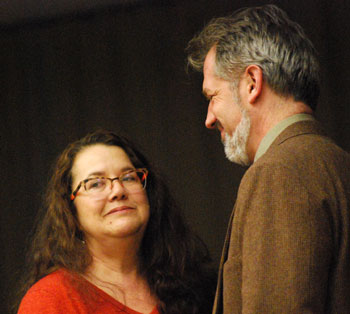
Ingrid Ault, chair of the city’s park advisory committee, spoke with Stephen Kunselman (Ward 3) before the March 3 meeting. Kunselman prevailed in the 2011 Democratic primary, a race the two both contested. They graduated Pioneer High School the same year.
Ingrid Ault addressed the council as current chair of the park advisory commission. She also spoke about the resolution on establishing an urban park. She reviewed for the council the work of a PAC subcommittee that made a recommendation to PAC that was then forwarded to the city council. PAC’s intent was that their recommendations would be the start of a conversation. She said that PAC does not object to constructing a park on the Library Lane site. But she stressed that the PAC recommendations included a clear process. She asked for postponement.
Doug Kelbaugh, former dean of the University of Michigan College of Architecture & Urban Planning, introduced himself by giving his downtown address on Ann Street. He ventured that everyone knew that downtown Ann Arbor has a really vibrant public realm – with a lively sidewalk life. But Ann Arbor lacks a real plaza – an outdoor civic space where people can gather for organize events, programmed events, or simply to enjoy the active and passive pleasures of living in the city, he said.
The site on top of the Library Lane parking structure is ideal for such a plaza, Kelbaugh said. It’s centrally located – near key destinations, near transit and parking, and open to the sun most of the day. It’s also structurally more suitable for a plaza than a park – because the parking deck is only strong enough for deep soil and large trees where there are columns below.
What makes a good urban plaza? Kelbaugh asked. He identified at least three things. [Kelbaugh was reprising remarks on plazas delivered at the Jan. 9, 2013 meeting of the Ann Arbor Downtown Development Authority board.] First is a sense of enclosure – like an outdoor room framed by neighboring buildings on at least three sites, he said. It needs something to generate activity, maybe a fountain or an ice rink, but with sufficient hardscape for events. A plaza also needs three active edges, with lots of people and eyes on the space, as well as transparent frontages, with entrances to a busy mixture of venues.
The north end of the proposed park, Kelbaugh said, is the side of the Earthen Jar building, which is low and has no entrances. And there’s an alley between it and the proposed park, further weakening that edge. There needs to be a new building at that edge – one with transparent and active edges, built from the outset. That’s because at the other end of the space, the Ann Arbor District Library’s current configuration does not really allow an entrance on the plaza. That other building needs to be there from the get-go, Kelbaugh said – to front the space, to monitor it, and to have eyes on it and perhaps to maintain the plaza.
Will the site to be big enough? Kelbaugh asked. He ventured that a small, busy plaza is arguably better than a large, empty one. The plaza envisioned in the 2008 scheme for a new library was roughly 90 feet x 90 feet – which is small enough to recognize a friend’s face or call someone’s name across the space. And it’s large enough for special events when that end of Library Lane can be closed. That would substantially increase the plaza’s footprint to about 90 feet x 150 feet, which is a good size and a good shape, he said. A downtown park would be wonderful, but a park should be on terra firma, he said, with more softscape and large trees – lots of them. The top of the Library Lane parking structure doesn’t seem to be that place, he said. Kelbaugh recommended a revised resolution.
Alan Haber said the issue of an urban park first arose when the city acquired the old Y lot and there was a question about what to do with the Y building. No private enterprise could do as much for Ann Arbor as Ann Arbor residents could do for themselves at that location, Haber said. He said the city should begin to ask residents to financially support a park on the Library Lane site. Patrons and pillars of the community would support it, he said. There can be other buildings, but for the western part of the Library Lane parcel, a park should be constructed, he said.
During his turn at public commentary at the start of the meeting, Jeff Hayner said he had actually intended to talk about the funding for the pedestrian task force, even though the agenda indicated he was to speak about the urban park. He added that it’s exciting to hear ideas about public space on the Library Lane site.
During public commentary at the end of the meeting, Kai Petainen said Ann Arbor is a world-class city. As long as the Library Lane parking structure is there, it makes sense to do something. He ventured that the space could be an indoor park.
Library Lane Urban Park: Mayor’s Presentation
Added to the agenda on the same day as the meeting was a presentation from mayor John Hieftje on downtown plazas. He thanked Jack Eaton (Ward 4) for putting the resolution about the urban plaza on the agenda, saying that he’d been planning to give the presentation a few weeks down the road, but he decided to move it up, given Eaton’s urban park resolution. [.pdf of slides presented on plazas]
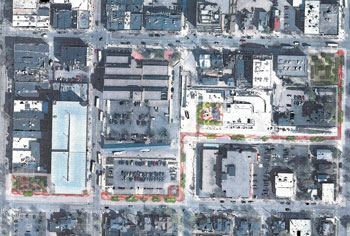
The path of a walk described by mayor John Hieftje in his presentation to the city council is highlighted in red.
Hieftje said he first started talking about this back in September 2012. He thanked Amy Kuras for putting together the drawings. He sketched out a walk starting at Liberty Plaza. The walk he described did not cross through the adjacent First Martin property, because the city doesn’t have an agreement to do that. The idea was to use decorative pavement in the sidewalk to create something like a “yellow brick road” that would lead people from a re-imagined and re-done Liberty Plaza, down Library Lane to a park on top of the Library Lane parking structure.
It would lead past the “Dahlmann Fountain” – a reference to Dennis Dahlmann’s recent purchase of the former Y lot – down the block past the Fourth & William parking structure and past a new park on the city-owned lot next to Palio restaurant. And continuing across the street you would get to the Kline’s lot on Ashley, where there could be another fountain, and more greenery at the end of the block. And then across Ashley, the city owns a small lot that would lead down to a greenway. So the walk that Hieftje described would connect up from Liberty Plaza to the greenway.
From Liberty Plaza in the other direction, heading east, the walk would go all the way through – with marked special pavement – to the University of Michigan Diag. Hieftje called the Diag the largest park in the downtown and it would continue to be that way, he said.
The reason Hieftje wanted to bring this forward, he said, was because he wanted people to think about the whole concept. The Allen Creek greenway has been under consideration for a long time, he said. He has been working with Chuck Warpehoski (Ward 5) and the Greenway Conservancy on a regular basis, he said. They have been making progress, but he allowed that the progress had been slow, saying that they have been trying to work on the issue during the worst economy since the 1930s.
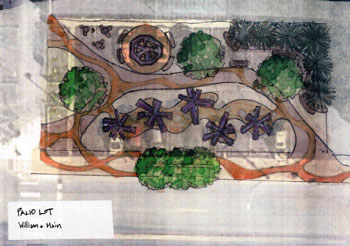
Sketch of possible park installation at the lot on the northeast corner of Main and William, next to Palio restaurant.
The progress that they’d been making was set back a little bit when the city was not awarded the Michigan Natural Resources Trust Fund grant for $300,000 to develop the 721 N. Main parcel. Now, the city is turning its attention back to 415 W. Washington, he said. City staff are working on a proposal to take to the city’s historic district commission to ask for permission to tear down the 415 W. Washington building. The report that had come back indicated that it would require a $6 million investment do anything with that building, he said.
Tearing down the building would clear the way for a greenway park, he said. The reason he wanted to put 415 W. Washington in this presentation was that a graduate class at the University Michigan had agreed to take on a project next fall for the development of a master plan. Students would pull together work that has been done on the greenway and develop a master plan, which would be helpful in applying for grants and in the discussion with the university. Hieftje said that 415 W. Washington might represent one of the best places to start.
The concept that he wanted people to think about – given that the greenway has been on the to-do list for very long time – was that the city needs to find a way to pay for it and maintain it, he said. One of the things that the city could do is to reach out and look for partners. He said there’s an opportunity to build on top of the Library Lane lot and at 415 W. Washington and on the Palio lot, and to find a partner to develop parks.
Hieftje pointed out that First Martin Corp. takes care of the city-owned park at Liberty Plaza. [.pdf of Liberty Plaza costs incurred by First Martin] First Martin also takes care of Wheeler Park, he believed. He said he was happy to hear Stephen Kunselman (Ward 3) say a couple weeks ago that Kunselman wanted to see the buildable part of the surface of the Library Lane parking structure sold. “I agree with that,” Hieftje said. He felt there was an opportunity to incorporate a park into the development so that the developer’s funds are used to build the park, and a developer’s funds would be used to maintain the park.
Hieftje stressed the idea of incorporating the construction of a park into a development agreement. He pointed out that 75% of Central Park in New York City had been paid for with donations. Hieftje felt like a partnership with a developer at 415 W. Washington could achieve the same kind of thing. An RFP (request for proposals) had been put out several years ago for the 415 W. Washington property. It had not been a very good time to do it, Hieftje said, but the climate had change greatly, he ventured. [For background on that RFP process, see Chronicle coverage: "City Restarts 415 W. Washington Process."]
He suggested trying to sell that property and to incorporate the development and maintenance of a greenway park in the development agreement. The same thing could be done with the Library Lane lot. He would not propose a park at the Palio lot if the city were not going to reach out to the Main Street Area Association and include those businesses. They could be included in the whole proposal as it is being put together, he said.
About the close-up slide on the Palio lot, Hieftje described it as taking a walkway that many people use now – to cut the corner by walking through the middle of the parking lot. There are play areas and a water feature included in the sketch, he noted.
Hieftje allowed that one of the shadows that hangs over any proposal for a new downtown park is Liberty Plaza, at the southwest corner of Liberty and Division. He ventured that there are not many citizens who think of Liberty Plaza as a place they want to visit – noting that the city has made great efforts to improve Liberty Plaza over the years. A lot of progress has been made, he said. Hieftje noted that Liberty Plaza needs to be leveled up. “We need to figure out a way to make Liberty Plaza a place where all of our citizens would like to go, where they’d like to sit and read a book. And it’s not that way now.”
Library Lane Urban Park: Council Deliberations
Jack Eaton (Ward 4) said he was pleased to bring the resolution forward as his first resolution as a councilmember. He’s been working with the Library Green Conservancy for several years, he said. He recounted the process that PAC had engaged in, saying that 76% of the public had called for more downtown parks. The resolution took the next “tiny step” in a long process, he said. PAC had made recommendations, and the resolution follows up on that, he noted. The resolution overlaps with the PAC recommendations with respect to a larger-than-5,000 square foot park at the Library Lane site. It’s not a huge park that’s recommended, he said – it’s 100 feet by 100 feet.
Stephen Kunselman (Ward 3) has asked for time to bring forward a companion resolution, Eaton reported, which raised the possibility that the item would be postponed.
Kunselman said he did want a postponement to have time to meet with some Ann Arbor District Library board members. But more importantly, he said, he wanted to list the property for sale.
The amount invested in the underground parking structure for future speculative development is about $15 million, Kunselman said. He read aloud a part of the city administrator’s commentary on the surface of the Library Lane structure, which essentially describes construction of a public space in concert with the private development of the property. Kunselman said he’s cautious about giving city staff too much to do. So he wanted to ask for postponement. He called the resolution lengthier than the one designating First & William as a park [which the council approved in the summer of 2009]. But as far as he knew, that resolution still stands. So he didn’t see this resolution as much different from that one.
Discussion then unfolded among Kunselman, Eaton, Hieftje, and city administrator Steve Powers on the right date to which it should be postponed. They settled on the following meeting, on March 17.
Sabra Briere (Ward 1) then tested the mood of the council for also holding a public hearing on the topic at the next council meeting, on March 17. Eaton didn’t think it was necessary.
Hieftje advised that the council not pursue a process that resulted in changing the categorization of the land to a park, because that would require an ordinance change. Hieftje said if the council decided at its next meeting that a public hearing were warranted, it could postpone again and set a public hearing.
Hieftje ventured that the park/plaza area could become a public space accessible to the public but not owned by the city. He noted that the city already has a lot of parks. If it were a vote today, Hieftje said he’d have a hard time putting this site ahead of 415 W. Washington for development as a park. He wanted to look at the issue in the context of all the city’s parks.
Kunselman said he would be talking to the library board about moving the library over to the surface of the Library Lane structure. He didn’t think the city would break even on the building rights for the top of the parking structure, given the amount of investment for development that has already been made. So he thought that partnering with a public entity might make more sense.
Sally Petersen (Ward 2) highlighted the distinction between a park and an urban plaza that Doug Kelbaugh had made during public commentary.
Eaton said he didn’t see a difference between a plaza and a park. Jane Lumm (Ward 2) agreed with Eaton. She said there’s a strong sentiment for something that’s not hardscape, but agreed with Eaton that they themselves are not park designers.
Christopher Taylor (Ward 3) said that he’d support the postponement, but asked that PAC be consulted on the resolution. He noted that PAC received the resolution as somewhat of an affront. The boundaries of the space will play a tremendous role, he said. That shouldn’t be set in stone. That could result in a park that can’t work, he said. “It cries for an integrated approach,” Taylor said. He hoped that the postponement can be used as an opportunity to rethink the “dip-the-Gordian-knot-in-concrete approach” of the resolution.
Mike Anglin (Ward 5) said the idea started in concept as a commons. He said it’s important to include the public in the process, and that’s what the resolution was trying to do. The library is the focal point, he said. With the cooperation of the library, something really good could be designed, he thought.
Implicitly responding to Taylor’s remarks, Eaton said that the location of the park was actually set in stone when the council approved the construction of the Library Lane parking structure – without knowing what would go on top. The location of the park is dictated by where the support columns were installed. The Library Green Conservancy needs definite boundaries so that it can start fundraising, he said. Eaton ventured that FAR [floor area ratio] premiums could be established in the zoning code for adopting a public park. Briere admonished Eaton to speak to the postponement.
Hieftje said it wouldn’t have made any sense to build the structure without adequate foundations to support building something.
Chuck Warpehoski (Ward 5) said that setting the boundaries is very important. He was concerned about the northern boundary. He encouraged the sponsors of the resolution to consider that. He was also concerned that the numbers don’t add up for him, in terms of what percent of the surface is being proposed for a park: Is it 20% or 40%?
Margie Teall (Ward 4) said she hoped during the period of postponement there would be some serious discussion with AADL about what their needs are. She said that the library has considered moving the building to the top of the parking structure and ventured that AADL has concluded it’s not in the AADL’s best interest. She said that if people had energy to put into the existing Liberty Plaza, it could serve the purpose of the community gathering space.
Outcome: The council voted to postpone until March 17 the resolution designating a portion of the Library Lane surface level as an urban park.
Parks Improvements
The council considered action on two city parks at its March 3 meeting – Clinton Park in the southern part of town and Gallup Park on the Huron River. For Clinton Park, the focus was new basketball and tennis courts. For Gallup Park, the council is looking to the state of Michigan to help fund a universal access playground. The Rotary Club of Ann Arbor has already pledged $250,000 toward the project. The city is applying for $300,000 from the state and would potentially add $100,000 of city funds, which would make a total project budget of $650,000.
Parks Improvements: Clinton Courts
The council was asked to consider a $133,843 contract with Best Asphalt to rebuild the tennis and basketball courts at Clinton Park. The city’s park advisory commission had recommended the contract at its Feb. 25, 2014 meeting.
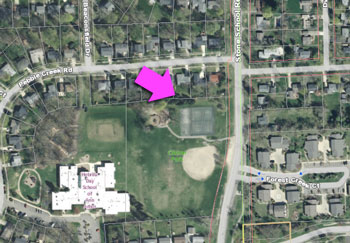
Clinton Park is located in the southeast part of the city, on Stone School Road, north of Ellsworth Road.
The park is located on the west side of Stone School Road, south of Eisenhower Parkway.
Including a 10% construction contingency, the project’s total budget is $147,227. Best Asphalt provided the lowest of five bids, according to a staff memo. The project will be funded with revenues from the park maintenance and capital improvement millage.
The scant remarks from councilmembers on the item stemmed from a question about where in the city the park is located.
Outcome: The council voted to approve the contract with Best Asphalt for repaving of the courts at Clinton Park.
Parks Improvements: Gallup Universal Access
The council considered approving an application for a grant from the Michigan Dept. of Natural Resources Grants Management (MDNRGM) to help fund the project.
PAC had been briefed on the proposal at its Jan. 28, 2014 meeting. Representatives of Rotary Club had attended that PAC meeting to convey the group’s $250,000 pledge. Colin Smith, the city’s parks and recreation manager, told park commissioners that although there are about 80 playgrounds in Ann Arbor, none are universally accessible. It’s a “huge shortcoming” for the parks system, he said.
The exact location within Gallup Park hasn’t been determined, but the playground would be about 5,000 square feet and exceed the requirements of the Americans with Disabilities Act (ADA). The design and equipment is intended to create environments that can be used by all people, with features like ramps, color-contrasting structures, wider bridges and walkways, and playground equipment that makes it easier for people using wheelchairs.
Parks Improvements: Gallup Universal Access – Public Commentary
During public commentary reserved time at the start of the meeting, Karen Kerry introduced herself as the president-elect of the Rotary Club of Ann Arbor. She noted that the Rotary Club’s Centennial co-chair, Bernie Lugauer, was also in the audience. She described the Rotary Club as an international humanitarian organization of professional men and women. The Rotary Club was started in the U.S. in 1905 and has grown into a worldwide organization of about 34,000 clubs and 1.3 million members, she told the council.

From left: Karen Kerry, president-elect of the Rotary Club of Ann Arbor, and Josie Parker, director of the Ann Arbor District Library. Parker is also a member of the Rotary Club.
The Rotary Club of Ann Arbor has nearly 350 members, she continued, about equally divided between town and gown. It’s about the 32nd largest Rotary Club in the world, she said. In addition to being one of the largest clubs, the Rotary Club of Ann Arbor is also one of the oldest – and in 2016 the club would be celebrating 100 years of service to the Ann Arbor community.
To mark that 100-year anniversary, the Rotary Club of Ann Arbor is partnering with the city of Ann Arbor’s parks and recreation department to build a state-of-the-art universal-access playground at Gallup Park, Kerry said.
The playground would be all-inclusive, she said. Regardless of age or ability, the playground would serve everyone. Playing, especially playing together, she said, isn’t just for those who can stand, run and jump. To that end, the Rotary Club is committed to raising at least $250,000 to support the construction of such a playground. That would be in addition to funding its ongoing programs at home and abroad, she explained.
Parks Improvements: Gallup Universal Access – Council Discussion
The item appeared with a group of other items on the consent agenda, but councilmembers can pull out items for separate consideration, which Jane Lumm (Ward 2) did. She acknowledged the Rotary Club’s gift in support of the park. “It’s just phenomenal,” Lumm said. “It’s breathtakingly generous.” Mayor John Hieftje added his own remarks of support.
Outcome: The council voted to approve the grant application for a universal access playground at Gallup Park.
Pedestrian Task Force Funding
The council considered a proposal to appropriate $197,250 to fund the work of a pedestrian safety and access task force. That amount includes an “estimated $122,500” as the approximate cost of the anticipated city staff effort for the project. The total project budget also includes $77,400 for a professional services agreement with Project Innovations Inc.
The funds were to be sourced in part from an allocation made during the May 20, 2013 budget deliberations, which appropriated $75,000 for a study to prioritize sidewalk gap elimination. The connection between sidewalk gaps and the task force’s work is based in part on one of the other “resolved” clauses establishing the task force: “… the task force will also address sidewalk gaps and create a tool for setting priorities for funding and filling those gaps; …”
The pedestrian safety and access task force was established through a council resolution passed on Nov. 18, 2013. Confirmed as members of the task force on Jan. 21, 2014 were: Vivienne Armentrout, Neal Elyakin, Linda Diane Feldt, Jim Rees, Anthony Pinnell, Sarah Pressprich Gryniewicz, Kenneth Clark, Scott Campbell, and Owen Jansson.
Another key “resolved” clause establishing the group’s scope of work includes the following: “… the task force will explore strategies to improve pedestrian safety and access within a framework of shared responsibility through community outreach and data collection, and will recommend to council improvements in the development and application of the Complete Streets model, using best practices, sound data and objective analysis.”
The responsibilities of the task force include delivery of a report a year from now – in February 2015.
The funding for the task force was in part to be used to pay for the $77,400 contract with Project Innovations Inc. to provide facilitator support to the task force.
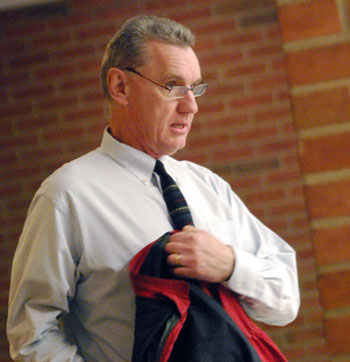
Frank Burdick spoke during public commentary against the funding allocation for the pedestrian safety task force and in particular against the funding of a contract with Project Innovations.
According to a staff memo written in response to councilmember questions, the facilitator would assist with an anticipated 18 task force meetings, 24 resource group (staff) meetings, five stakeholder meetings and three public meetings. The facilitator would be “preparing materials and agendas; facilitating the meetings; summarizing the meetings; facilitating communication and discussions between, and among, the task force members and the resource group; and, developing materials for community outreach in addition to the actual public meetings, including content for press releases and web page publishing, and a community survey.”
According to the staff memo accompanying the resolution, a “team of staff members has identified Project Innovations, Inc. as a firm in the region that has demonstrated skill in task force facilitation and robust community engagement efforts, and is uniquely qualified with the capacity to facilitate the pedestrian safety and access task force’s rigorous work approach within the specified timeframe.” Based on the phrasing in the memo, the work appears not to have been put out to bid and Project Innovations was identified as a “sole source” provider.
Project Innovations is the same firm currently providing facilitation support to a citizens advisory committee that is attached to a sanitary sewer wet weather evaluation study being conducted by the city.
The resolution establishing the pedestrian safety task force did not explicitly charge the group with a review of the city’s crosswalk law. But the pedestrian safety task force was established in the same time frame as the council was considering an amendment to the city’s crosswalk law. The council ultimately voted to change the language of that law at its Dec. 2, 2013 meeting – so that motorists were required to concede the right-of-way only to pedestrians who had already entered the crosswalk.
That change was subsequently vetoed by mayor John Hieftje. Drawing on the phrasing used in Hieftje’s statement of veto, Stephen Kunselman (Ward 3) has indicated he intends to bring forward an amendment that would require motorists to stop at crosswalks for pedestrians only if “they can do so safely.” At the council’s Feb. 18, 2014 meeting, Kunselman announced he’d be pursuing such an amendment.
In the same time frame when the council considered the revision to the crosswalk ordinance and established the pedestrian safety task force, the council also made an $125,000 allocation, at its Dec. 16, 2013 meeting, for increased traffic enforcement. At that same meeting, the council passed a resolution directing city administrator Steve Powers to develop a funding and implementation plan for the city’s non-motorized plan. The first report on that, focusing on improvements to pedestrian safety in the downtown, was due to the council by March 1. The report, dated Feb. 28, was attached to the March 3, 2014 meeting agenda. [.pdf of Feb. 28, 2014 city administrator report on non-motorized plan implementation]
Pedestrian Task Force Funding: Public Commentary
During his turn at public commentary at the start of the meeting, Jeff Hayner asked for some leadership that will save some money for the city. By his reckoning, there was more than $1 million that could be saved. He identified $77,000 in consulting for the pedestrian task force as one area of savings.
Frank Burdick asked that the council vote no on the funding of the consultant for the pedestrian task force. He said the city already has staff who are competent to facilitate the work of the task force, and he weighed in against hiring Project Innovations to do the work. He expressed dissatisfaction with PI for its work with the wet weather sanitary sewer evaluation study. He spoke from his perspective, serving on a citizens advisory committee for that project.
Pedestrian Task Force Funding: Council Deliberations
Sabra Briere (Ward 1) recalled Stephen Kunselman’s (Ward 3) comments from earlier in the evening, when he said that it’s easy to direct staff to do things. She wanted to postpone the item until the first meeting in April – on April 7. She ventured that the scope of work might be different by then and the budgeted amount might also be different.
Sally Petersen (Ward 2) supported the postponement. She hoped the task force would meet before April 7. She was concerned about assigning the task force the task of addressing sidewalk gaps. She also suggested separating out the Project Innovations contract into a separate resolution. Briere responded by saying she’s not even sure that the recommendation for an outside consultant would be part of the proposal when it comes back on April 7. Briere said the task force could meet before this resolution.
Briere identified Connie Pulcipher as the city staff member who’d support the task force. City administrator Steve Powers weighed in, pointedly saying that the staff assignment would be made by staff. Responding to Petersen’s comment, he noted the resolution is much broader than the sidewalk gaps issue. Briere apologized for saying Pulcipher had been assigned, saying she thought Pulcipher had already been identified.
Jane Lumm (Ward 2) said she’d support the postponement. But she was concerned about language in the resolution that indicated additional funding could be requested in the future.
Outcome: The council voted to postpone the funding for the pedestrian safety task force until April 7, 2014.
Target Pedestrian Safety Traffic Enforcement
Commenting on the dedicated overtime traffic enforcement initiative, police chief John Seto told the council that the Ann Arbor police department had given the program an internal name: “26 weeks to Safer Streets.”
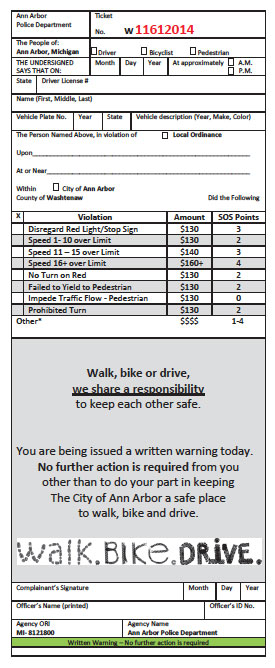
Educational pamphlet handed out as warnings as a part of traffic enforcement in Ann Arbor. In format, they resemble a ticket.
The first date when officers were deployed for the program was on Jan. 9, he reported. For the first two months, on two days a week there were officers assigned to either four- or eight-hour shifts. A total of 47 different officers have worked the detail so far, he said, and 450 hours of overtime have been scheduled. That’s about 24% of the hours the department had estimated would be scheduled during the program. About $26,000 of overtime has been used, which is about 21% of the $125,000 that had been allocated.
About 80% of the enforcement time focused on some type of pedestrian-related safety concern – such as crosswalks, or failing to yield at a red light or stop sign. The other 20% involve speeding or disregarding traffic control devices. There have been 40 separate dedicated locations of enforcement throughout the city, Seto said, 14 of which have been in the downtown and student areas. A total of 363 traffic stops have been made, and 166 citations have been issued – which accounts for about 46% of the total stops. Of those contacts, 197 resulted in warnings or educational opportunities, which is about 54% of the stops, he said.
Seto showed the council a copy of the educational handout that had been distributed in connection with traffic stops. He told them it was effective because it looks like a ticket, but is actually educational material. [.pdf of Walk-Drive-Ped-Card] When people find out it is not a ticket and they don’t actually have to pay the fines or the points they would have received, it’s proven effective, he said.
The locations for enforcement were identified through citizen complaints, Seto explained, in part through the complaint questionnaire that went live on Jan. 13, 2014. Since its implementation, 47 separate questionnaires have been completed, he told the council. And they have been used to help identify locations of enforcement.
Seto indicated that the harsh weather that the city had experienced over the last two months has likely decreased the number of traffic violations that the officers have seen. That’s the reason the department has expended only 21% of the overtime for the first 1/3 of the program. The department plans to increase its deployment over the next few months as the weather warms up.
Seto indicated that the visible presence of officers at the target locations has been beneficial. Although the first phase has used locations identified through complaints, the next phase will include areas that in the police department’s judgment are in need of additional enforcement – such as areas of high incidence of traffic crashes.
Crime Statistics Update
Police chief John Seto also briefed the council on year-end crime statistics. Background materials attached to the agenda included historical crime data: [.pdf Ann Arbor 2013 crime stats]
Part I crime totals for 2013 were 2,827, down from 3,059 in 2012. Part II crime totals for 2013 were 3,625, down from 3,883 in 2012. Total crimes for 2013 were 6,452, down from 6,942. That’s a 7% drop.
Seto stressed that the numbers being reported were not the official FBI numbers but they are the internal Ann Arbor police department numbers that are reported to the FBI. For 2013, he said, the year-end reported number of Part I crimes was 2,827. [Part I crimes include: criminal homicide, forcible rape, robbery, aggravated assault, burglary (breaking or entering), larceny, motor vehicle theft and arson.] That represented about an 8% reduction compared to the previous year, Seto said.
The most significant area of reduction was in the area of break-ins – which includes home invasions and break-ins into businesses. In 2013 there were 427 break-ins, which is the lowest reported number for at least the last 10 years, Seto said. That’s a 42% reduction compared to the previous year.
However, Seto urged caution when looking at crime statistics. One crime is one crime too many, he said, especially when it comes to violent crimes. In 2013 there were two homicides, Seto noted, and he was grateful for the hard work of the detectives and officers that led to arrests in both of those instances. He also stressed the importance of looking at crime statistics not just as a snapshot from one year to the next, but also to consider statistics over an extended period of time – statistics over many years.
He noted that the council had been provided with a table of crime statistics going back to 2002. He said those statistics indicated that there seemed to be a jump in crime every 3 to 4 years – but the overall trend has been for a steady reduction since 2002.
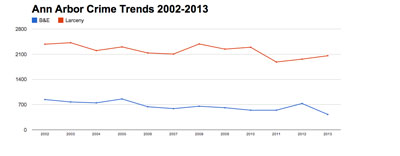
Ann Arbor crime statistics from 2002 through 2013 for larceny (red) and burglary (blue). (Data from the AAPD. Chart by The Chronicle.)

Ann Arbor crime statistics from 2002 through 2013 for Part I crimes except for larceny and burglary. (Data from the AAPD. Chart by The Chronicle.) The downward trend is consistent in every category except for sex crimes (red).
The city makes daily crime data available in a six-month rolling window through crimemapping.com.

Ann Arbor monthly crime statistics for burglary. (Data from crimemapping.com. Chart by The Chronicle.) The drop in burglaries appears to have occurred after a relative high in December 2012.
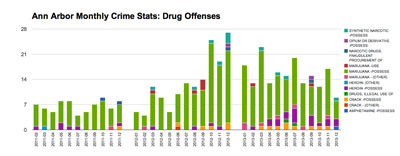
Ann Arbor monthly crime statistics for drug offenses (Data from crimemapping.com. Chart by The Chronicle.) The bulk of drug offenses are marijuana possession (green). Although the actual numbers are low, incidences of crack offenses (orange) and heroin offenses (purple) seem to becoming more frequent.
Sidewalk Design, Construction
The council considered a design contract for two stretches of new sidewalk in two parts of the city – Barton Drive and Scio Church Road. Also considered at the council’s March 3 meeting was a $30,000 budget allocation for the construction of a sidewalk as part of the Ann Arbor-Saline road reconstruction project.
Sidewalk Design, Construction: Barton, Scio Church
As part of a contract to design urgent repairs to the sanitary sewer pipes and structures in Huron Street near the intersections of Glen Street and Zina Pitcher, Fishbeck, Thompson, Carr & Huber Inc. was tapped to provide the designs for two sidewalk projects that could ultimately result in special assessments for adjoining property owners.
By way of background, at its July 15, 2013 meeting, the council approved $15,000 for preliminary design of a sidewalk along Barton Drive.
And at its Nov. 19, 2012 meeting, the council approved $15,000 for preliminary study of a sidewalk to be constructed along Scio Church, west of Seventh Street. On Nov. 7, 2013, the council approved another $35,000 for Scio Church sidewalk design work.
The contract with Fishbeck, Thompson, Carr & Huber Inc. – which includes $50,629 for the design of the two stretches of sidewalk – would draw on that previously authorized funding.
The scant council remarks consisted of comments from Sabra Briere (Ward 1), who said that residents all over the north side of town have been asking for a sidewalk connection along Barton Drive ever since the boardwalk was constructed.
Outcome: The council voted to approve the contract with Fishbeck, Thompson, Carr & Huber Inc.
Sidewalk Design, Construction: Ann Arbor-Saline
The council considered a $30,000 general fund expenditure to pay for a new sidewalk along the east side of Ann Arbor-Saline Road from the westbound I-94 exit ramp to the north end of the I-94 bridge, and along the west side of Ann Arbor-Saline Road from Brookfield Drive to the Michigan Dept. of Transportation (MDOT) park-and-ride commuter parking lot. The work is part of a more general road reconstruction project being handled by MDOT under an agreement between the city of Ann Arbor, the Washtenaw County road commission, MDOT and Pittsfield Township. Fishbeck, Thompson, Carr & Huber Inc. also did design work for this project.
Outcome: The council voted without discussion to approve the $30,000 for new sidewalk construction on Ann Arbor-Saline Road.
Outdoor Smoking Law
The council was asked to consider initial approval of a local law regulating smoking in some outdoor locations. The law would regulate smoking outside of public buildings and also potentially in areas of some city parks.
The new ordinance had been postponed at the council’s Feb. 3 meeting.
Chuck Warpehoski (Ward 5), sponsor of the new proposed local law, had appeared before the city’s park advisory commission at its Feb. 25 meeting to brief commissioners on the proposal and solicit feedback.
Made punishable under the proposed ordinance through a $50 civil fine would be smoking within 20 feet of: (1) bus stops; (2) entrances, windows and ventilation systems of the Blake Transit Center; and (3) entrances, windows and ventilation systems any city-owned building.
The ordinance would also authorize the city administrator to have signs posted designating certain parks or portions of parks as off limits for outdoor smoking, and to increase the distance from entrances to city buildings where outdoor smoking is prohibited.
Where no signs are posted noting the smoking prohibition, a citation could be issued only if someone doesn’t stop smoking immediately when asked to stop.
An existing Washtenaw County ordinance already prohibits smoking near entrances, windows and ventilation systems, according to the staff memo accompanying the resolution – but the county’s ordinance can be enforced only by the county health department. The memo further notes that the Michigan Clean Indoor Air Act does not regulate outdoor smoking.
Outdoor Smoking Law: Council Deliberations
Chuck Warpehoski (Ward 5) led off by noting that the clerk had forwarded to people a substitute amendment. He characterized the changes as minor to make the wording more clear.
Warpehoski noted that the ordinance was on the agenda as just a first reading. He indicated he was willing to postpone consideration of the ordinance again, in the context of some information that was provided only just today. [That included a statement of support from Tobacco Free Michigan, and a statement from Clifford Douglas, director of the University of Michigan Tobacco Research Network.]
Jane Lumm (Ward 2) asked Warpehoski what the outcome of the consultation with PAC and the business community had been. Warpehoski indicated that he had not yet moved forward with consultation with the business community.
Lumm asked what the reaction of the Ann Arbor Area Transportation Authority had been. Warpehoski said the challenge that AAATA had identified was enforcement. But AAATA would like its bus stops to be smoke-free, he reported.
Lumm wondered how the areas in public parks would be designated as smoke-free. Stephen Kunselman (Ward 3) said he’d had some concerns when he first saw this proposal and he still has them. He did not want people calling 911 to resolve personal space issues – just because someone is smoking a cigarette. He wouldn’t support having Ann Arbor’s police officers chasing people who are smoking cigarettes.
Kunselman also said that not all “city employees” should be able to issue citations. He noted that the University of Michigan went smoke-free, without a penalty. But if you work for UM and you get caught smoking, that could have implications for your job, he allowed. He wondered why Washtenaw County passed an ordinance that designates the health department as the enforcer, instead of the sheriff’s office. He ventured that it’s because the county didn’t want sheriff’s deputies chasing people for smoking cigarettes.
Warpehoski agreed that he didn’t want people calling 911 about outdoor smoking. He said the parks and recreation manager, Colin Smith, indicated that he thought it would likely be self-enforced or not.
Kunselman came back to the issue of who can issue a ticket. He said the effort needs to be thought out again. If you’re in front of a judge for smoking a cigarette, that’s a problem, he said. He drew a distinction between rudeness and unlawful activity.
Mike Anglin (Ward 5) focused on the issue of penalties. He wanted to know if being fined under this ordinance would remain as part of someone’s record. City attorney Stephen Postema said it would be like any ticket.
Anglin asked if it would be a misdemeanor. Postema said it would be a civil infraction. Postema explained that a civil infraction is not a violation of the criminal code. Sabra Briere (Ward 1) asked for examples of a civil infraction. City administrator Steve Powers gave as an example the failure to remove snow or ice from a sidewalk.
Sally Petersen (Ward 2) said she wanted to postpone the ordinance. She liked the intent, but thought there should be a better way to enforce it. She wanted to give Warpehoski time to sort things out.
Warpehoski suggested the council’s first meeting in April as the date to which it could be postponed.
Lumm supported postponement, saying that there are a lot of unanswered questions. She said she didn’t believe in voting for something at first reading just to get it to second reading.
Jack Eaton (Ward 4) said that he’s a non-smoker and finds secondary smoke offensive, but he had problems with the proposed ordinance. He called the ordinance next-to-impossible to enforce – noting it takes maybe seven minutes to smoke a cigarette. He also had concerns about the disparate impact on the homeless. He noted that the fine for having marijuana is $25. He hoped that the focus can be narrowed to just around public buildings.
Christopher Taylor (Ward 3) indicated he would not support the postponement. He said there’s been a “parade of horribles” about the social consequences of this ordinance, which he didn’t think were warranted. He ventured that in most cases, interactions would unfold along the lines of someone pointing out to a smoker that according to the sign, smoking is not allowed – with swift compliance by the smoker. He wanted to see the ordinance move forward to second reading.
Warpehoski complained that he’d asked councilmembers a month ago, on Feb. 3 – when the ordinance was first on the agenda and he’d himself asked for a postponement – if they had any questions or concerns. And he was only hearing their concerns now at the March 3 meeting.
Outcome: The council voted to postpone the ordinance until April 7, over dissent from Hieftje and Taylor.
Outdoor Smoking: Public Commentary
During public commentary at the end of the meeting, Seth Best thanked the council for their work. He was there speaking as a smoker. He liked the idea of allowing people to perform community service as an alternative to a fine. He also suggested that punishment could include voluntary smoking cessation intervention.
Affordable Housing Budget
The council considered a resolution directing the city administrator to prepare for the council’s approval a budget resolution that would allocate $600,000 from the city’s affordable housing trust fund to support the Ann Arbor housing commission’s plan to renovate its properties.
That allocation would be contingent on the closing of the sale of the former Y lot to Dennis Dahlmann, as the net proceeds of that sale are to be deposited into the city’s affordable housing trust fund.
The resolution had been postponed at the council’s Feb. 18 meeting. It was postponed only after the council’s two liaisons to the housing and human services advisory board – Sabra Briere (Ward 1) and Jane Lumm (Ward 2) – had aired out conflicting perspectives on the importance of having the item on the agenda that evening. Briere had placed the item on the Feb. 18 agenda. Lumm argued that the agenda placement had come late on Friday and that it was not necessary – for the housing commission’s purposes – to vote on the issue until March 3.
Politics between the city council and the Ann Arbor Downtown Development Authority are also a part of the mix, as the housing commission has made a $600,000 request of the DDA as well. It appears that the DDA is likely to meet that request over the course of three years, with $200,000 payments each year.
Council deliberations were brief. Briere reviewed the content of the resolution. The city does not yet have the money from the sale of the Y lot, she noted.
Lumm pointed out that her objection at the last meeting was a concern about process. She said this money is essential to the AAHC’s strategy for rehabilitating its properties.
Outcome: The council voted to direct the preparation of a budget amendment to make an allocation from the affordable housing trust fund to the Ann Arbor housing commission.
Vehicle Replacement
The council was asked to authorize the purchase of 18 new vehicles from Signature Ford in Perry, Michigan. Most of the new vehicles are for use by the Ann Arbor police department. Total cost of the purchase was $457,393 and included:
- one 2014 Ford F-150 four-wheel-drive pickup at $26,407.
- one 2014 Ford Escape four-wheel-drive at $24,050.
- four 2014 Ford Police Interceptors: Sedans at $24,601 each.
- nine 2014 Ford Police Interceptors: Utility at $26,298 each.
- two 2014 Ford Police Interceptors: Utility with rear-auxiliary air-conditioning for use as K-9 units at $26,846.
- one 2014 Ford F-150 two-wheel-drive pickup at $18,158.
The staff memo accompanying the resolution noted that the police vehicles to be purchased will replace vehicles that will have reached either the 80,000-mile or the six-year limit specified in the city’s labor contracts with the Ann Arbor Police Officers Association and the Ann Arbor Police Supervisors.
The memo further noted that the new sedans have less shoulder room than Crown Victorias. So the AAPD is finding it difficult to install the increased amount of equipment needed in police vehicles, while still maintaining adequate room for officers. That’s why more of the SUV pursuit-rate vehicles are being incorporated into the police department’s fleet.
The city’s non-police vehicles are subjected to a two-step process to determine replacement. According to the staff memo accompanying the resolution, the first step scores a vehicle’s age, miles/hours of use, type of service, reliability, maintenance and repair cost. The second step is review of the vehicle repair history and general condition.
One non-police vehicle to be replaced through the purchase is a truck that has been in service for 7.6 years and has over 4,800 total hours of operation, averaging 0.23 repair work orders per month. The total cost of repairs has exceeded 60% of its purchase price.
Outcome: The council voted without discussion to approve the vehicle purchase.
More Fire Protection
The council considered a resolution calling for higher funding levels for an existing state fire protection grant program.
The state grant program, which has historically varied in amount from year to year, was enacted to address the fire protection costs incurred by local municipalities that are home to state-owned institutions – like the University of Michigan. State law sets forth a formula to set funding levels for all Michigan municipalities where state-owned facilities are located. But the law also allows the legislature to fund only a percentage of the amount that results from the formula-based calculation.
The council’s March 3 resolution encouraged Gov. Rick Snyder, state senator Rebekah Warren (D-District 18), and state representatives Jeff Irwin (D-District 53) and Adam Zemke (D-District 55) to explore creative ways to fund the state’s fire protection grant program for municipalities like Ann Arbor, which host state-owned facilities.
By way of additional background, state-owned institutions like the University of Michigan, located in Ann Arbor, do not generate property tax revenue, which is used to pay for fire protection, among other basic services.
UM does not operate its own fire protection service, but Ann Arbor’s fire station #5 is located on university property, for which the university does not charge rent, utilities, or maintenance costs. UM estimates the annual value of that arrangement to the city at about $230,000.
In general, however, the Michigan legislature recognizes that municipalities hosting state-owned facilities face a burden of providing fire protection for such facilities – without receiving property tax revenues to pay for that fire protection.
So the legislature enacted a law to award fire protection grants from the state of Michigan – which are dependent on an allocation from the state legislature each year. The allocation is governed by Act 289 of 1977. [.pdf of Act 289 of 1977] The statute sets forth a formula for a state fire protection grant to all municipalities that are home to state-owned facilities – a formula that attempts to fairly determine the funding allocated for fire protection grants in any given year. The fire protection grant formula is defined for any municipality in terms of the relative value of the state-owned property in the municipality.
More precisely, the percentage in the grant formula is the estimated state equalized value (SEV) of state-owned facilities, divided by the sum of that estimated value and the actual SEV of the other property in the community. For example, in Ann Arbor, the total SEV of property on which property tax is paid is roughly $5 billion. The estimated value of state-owned facilities (primarily the University of Michigan) is around $1 billion. So the percentage used in the state fire protection formula for Ann Arbor is about 16% [1/(1 + 5)].
The percentage in the formula is different for each municipality. That percentage is then multiplied by the actual expenditures made by a municipality for fire protection in the prior fiscal year.
The formula can be described as equitable among municipalities – because the grant amount depends in part on the relative value of state-owned facilities in a given municipality. All other things being equal, a city with a greater number of state-owned facilities receives more fire protection grant money than one with a small number of state-owned facilities. The formula can also be described as equitable to the state of Michigan, because the formula calibrates the state’s investment in a municipality’s fire protection to the level of funding that a local municipality itself is willing to provide.
The roughly $14.8 million in a provisional budget request from the Ann Arbor fire department for FY 2015 would translate to a state grant of roughly $2.3 million.
But the state statute explicitly provides for the possibility that the legislature can choose not to allocate funds sufficient to cover the amount in the formula [emphasis added]:
141.956 Prorating amount appropriated to each municipality.
Sec. 6. If the amount appropriated in a fiscal year is not sufficient to make the payments required by this act, the director shall prorate the amount appropriated to each municipality.
Since 1996, the legislature has funded the grants at amounts as low as 23% of the formula to as high as 68%. For the five-year period from 2007 through 2011, the legislature funded the same dollar amount of about $10.9 million statewide, but that translated into diminishing percentages over the five-year span. In the last three years, the program has been only 40-55% funded.

State of Michigan Fire Protection Grants: Actual Dollars. (Data from state of Michigan, chart by The Chronicle.)
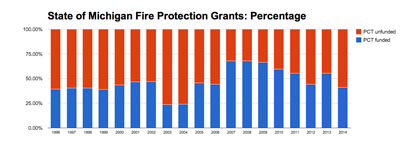
State of Michigan Fire Protection Grants: Percentage of Formula Funded. (Data from state of Michigan, chart by The Chronicle.)
More Fire Protection: Council Deliberations
Jane Lumm (Ward 2) said she sponsored the resolution but noted that it originated with city staff and the city’s lobbyist, Governmental Consultant Services Inc. (GCSI). She reviewed the background of the fire protection grant funding.
Mayor John Hieftje said he’d made a couple of trips to Lansing to stand with other mayors and fire chiefs to ask the state legislature to fund its own formula. He noted that the estimated taxable value of University of Michigan property is around $1 billion.
Hieftje hoped this issue gets more traction in Lansing this year.
Outcome: The council voted to approve the resolution calling on state officials to find ways to fund the fire protection grant program.
Communications and Comment
Every city council agenda contains multiple slots for city councilmembers and the city administrator to give updates or make announcements about important issues that are coming before the city council. And every meeting typically includes public commentary on subjects not necessarily on the agenda.
Comm/Comm: Potholes
Near the start of the meeting, during his communications time, city administrator Steve Powers gave an update on local road conditions. He began by saying there was statewide interest in road conditions. Requests on potholes through the end of February 2014 totaled 283 compared to 46 last year. This year so far, 251 tons of cold patch have been used. Last year by this time, 100 tons had been used.
Powers indicated that the city was responding daily, if not more frequently, to issues on eight major thoroughfares. The city was still trying to maintain its 24-hour response to any pothole request. He allowed that the city is not achieving the 24-hour goal 100% of the time, but was still striving for that goal. The difficulty in achieving that goal relates to other weather-related needs that the field operations staff has to respond to, he said.
Comm/Comm: Environmental Commission
Sabra Briere (Ward 1) said she and Mike Anglin (Ward 5) would be bringing forward appointments to the environmental commission (EC). The two people are re-appointments: David Stead and Susan Hutton. She would also like additional applicants for the EC, she said. The EC has asked for people with specific expertise in chemistry, urban forestry, and water issues. Briere also wanted to highlight the EC work plan in the attachments to the agenda. [.pdf of EC work plan]
Comm/Comm: R4C/R2A
Sabra Briere (Ward 1) also highlighted that the council has received a report from the R4C/R2A advisory committee. She hoped people will take time to read the report. [.pdf of advisory committee report]
Comm/Comm: Agenda Attachments, Minutes
During public commentary at the end of the meeting, Ed Vielmetti addressed the council highlighting items from the clerk’s report. He read aloud from communications sent to the city by students at Pattengill Elementary School, who complained about the lack of snow plowing near their school. Vielmetti also highlighted the 2009 Ann Arbor Downtown Development Authority annual report, which was just now attached to the March 3 meeting agenda. He pointed out a very late set of historic district commission minutes that were attached to this meeting’s agenda.
Present: Jane Lumm, Mike Anglin, Margie Teall, Sabra Briere, Sumi Kailasapathy, Sally Petersen, Stephen Kunselman, Jack Eaton, John Hieftje, Christopher Taylor, Chuck Warpehoski.
Next council meeting: Monday, March 17, 2014 at 7 p.m. in the council chambers at 301 E. Huron. [Check Chronicle event listings to confirm date.]
The Chronicle could not survive without regular voluntary subscriptions to support our coverage of public bodies like the Ann Arbor city council. We sit on the hard bench so that you don’t have to. Click this link for details: Subscribe to The Chronicle. And if you’re already supporting us, please encourage your friends, neighbors and colleagues to help support The Chronicle, too!




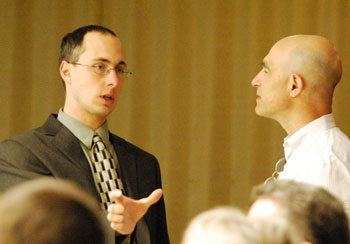
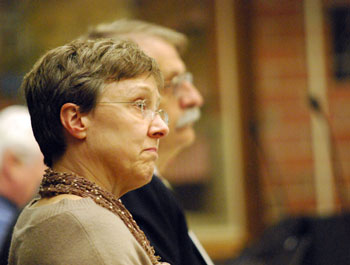


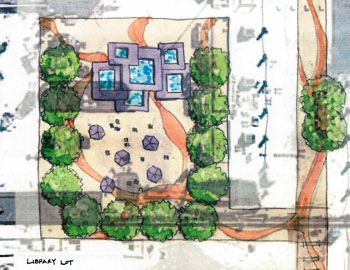
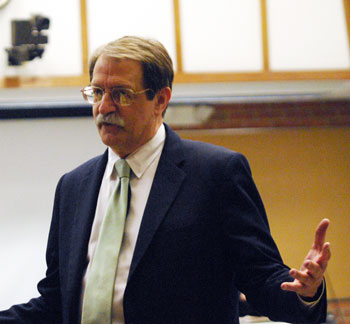
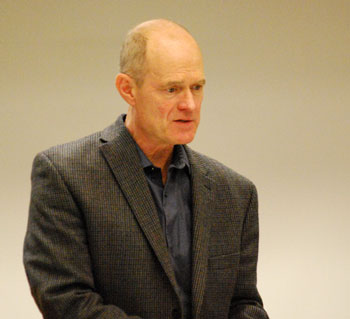

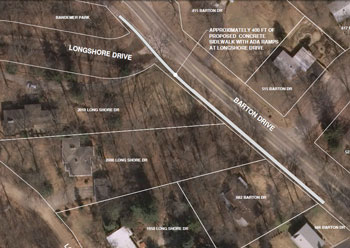

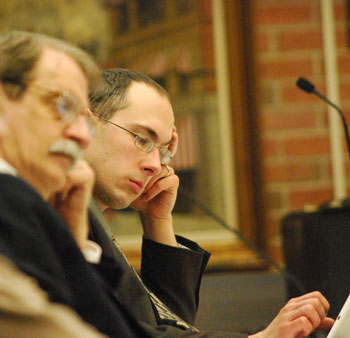
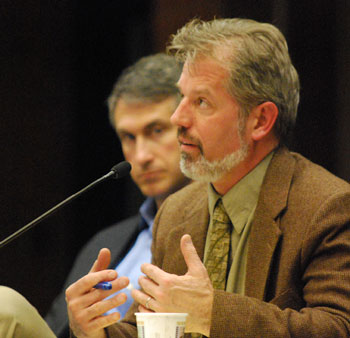
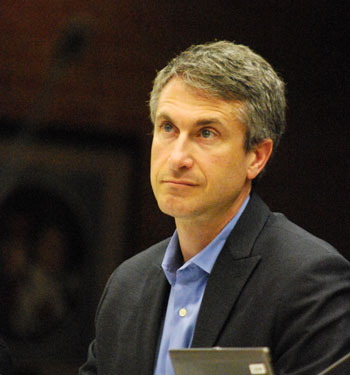
“Hieftje ventured that the park/plaza area could become a public space accessible to the public but not owned by the city.”
This approach may sound reasonable but builds in a lot of conflicts for the future. A space that fronts a busy enterprise would necessarily be restricted in its use by the public. There are many possible scenarios. I can imagine that police would even be called in to enforce access to the building under circumstances I can visualize.
The open area that passes through the Ashley Mews development was originally designated as public access, including as a pedestrian passage from Ashley. Public money was used to subsidize this development. However, I’ve heard anecdotes that passers-by have been advised by residents that this is a private space.
We need a public open space in the downtown that is unequivocally public. Despite all efforts, Liberty Square has failed to fill that need.
Missing from the reporting of my remarks is my refuting the remarks made by Julie Grand, who insisted that the PAC required robust public participation on anything to do with the Library Lot or a downtown park. I commented that I don’t recall an especially robust public process in approving the additional expenditure of in excess of $5 million dollars worth of foundation work to support a convention center on the Library Lot. The PAC worded their condition statements for a downtown park carefully, led by CM Taylor, in order to avoid having anything built, or set aside, that is not in the best interests of business. There is very little respect given to the public’s interest in this matter.
I sincerely hope that Mr. Hayner understands that PAC had nothing to do with the design of the parking structure. PAC did recommend a robust public process moving forward on the Library Lot. A process that occurred outside of PAC’s influence in the past has nothing to do with a desire to solicit future public input.
The potential for a developer to fund, program, maintain, and activate a potential public space, in my opinion, is in the public’s best interest. This type of fiscally responsible cooperation will allow Parks and Recreation to focus on the maintenance and improvement of our 157 parks while simultaneously providing public open space that is desired by the community.
Re: #3. Of course I know that PAC did not design the Library Lot. What they did do was create a set of conditions for the development of any downtown park, including the Library Lot, that are so narrow as to rule out any use that is not favorable to the interests of downtown business. As for Ms. Grand’s opinion as to what is in the public’s best interest, remember; despite her appointment and service to the PAC (the mayor’s city council farm club, it would appear), she is but one member of our public. We have heard PAC’s opinion as to what characteristics might best define a downtown park, now we are hearing from others, and a truly public process has begun. That this conversation is now happening in a larger arena, outside of the PAC’s political influence, is, in my opinion, in the public’s best interest.
There is plenty of $$ in the General Fund to maintain parks. It’s simply a matter of priorities, whether for parks, police, “Art”, the urban forest, pothole filling, or the DDA’s tax increment financing scheme.
The premise of the A2D2 re-zoning was that oodles of new tax revenue would result from all this “Economic Development”. Six or eight new buildings have been erected. Where’s the dough? Of does the dough not flow until the Library Lane park has been paved over?
Re #5: Last year’s budget increased parks funding. There is an increase in fire funding as the general fund takes on the costs of the firefighters initially hired with the SAFER grant. The initial staff budget notes include a potential increase in police officers.
Thanks for the update, Chuck!
The article reports “Christopher Taylor (Ward 3) noted that law enforcement will get $44.5 million of next year’s general fund budget …” I think CM Taylor probably meant “public safety” (police plus fire) not just “law enforcement”.
In the FY 2014 budget, public safety received about $39 million of the total $81 million spent on “recurring” expenses. I’m pretty sure that there is no plan to spend more on police services in the next fiscal year than we spent on the combined police and fire services in the current fiscal year.